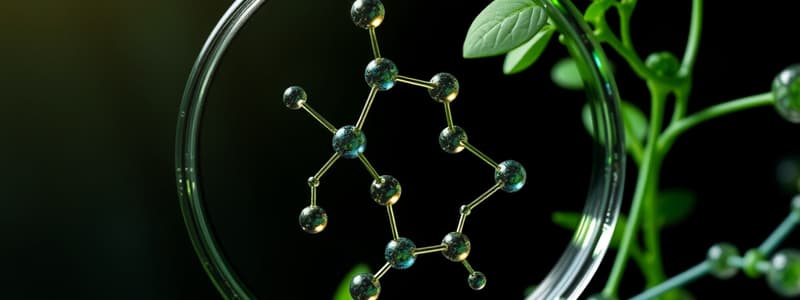Podcast
Questions and Answers
What is green chemistry?
What is green chemistry?
The design of chemical products and processes that reduce or eliminate the use and generation of hazardous substances.
Which of the following is NOT one of the 12 Principles of Green Chemistry?
Which of the following is NOT one of the 12 Principles of Green Chemistry?
- Atom Economy
- Prevention of waste
- Design for Energy Efficiency
- Increased use of toxic substances (correct)
The principle of Atom Economy requires maximizing the incorporation of all materials into the final product.
The principle of Atom Economy requires maximizing the incorporation of all materials into the final product.
True (A)
What is the aim of pollution prevention hierarchy in green chemistry?
What is the aim of pollution prevention hierarchy in green chemistry?
The major sources of waste in green chemistry include stoichiometric reagents and _____ losses.
The major sources of waste in green chemistry include stoichiometric reagents and _____ losses.
What case study is provided to demonstrate the principle of prevention of waste?
What case study is provided to demonstrate the principle of prevention of waste?
What is the greenest option according to pollution prevention hierarchy?
What is the greenest option according to pollution prevention hierarchy?
Flashcards are hidden until you start studying
Study Notes
Green Chemistry Overview
- Green chemistry focuses on designing chemical products and processes that minimize or eliminate hazardous substances.
- Examines pollution prevention at the molecular level, emphasizing sustainable practices.
Key Concept: Reducing
- Central to green chemistry principles including:
- Cost reduction
- Material utilization
- Risk and hazard reduction
- Energy conservation
- Waste minimization
- Usage of renewable resources
The 12 Principles of Green Chemistry
- Developed by Anastas and Warner, aiming for safer, more efficient chemical processes:
- Prevention of Waste: Proactive approach is preferred over remediation after waste has been created.
- Atom Economy: Emphasizes maximizing the inclusion of all materials in the final product to minimize waste.
- Less Hazardous Chemical Syntheses: Focuses on designing processes that decrease chemical hazards.
- Design Safer Chemicals: Ensuring the inherent safety of chemicals used.
- Real-time Analysis for Pollution Prevention: Encouraging immediate monitoring for pollutants to prevent their creation.
- Use Safer Solvents: Advocating for safer solvent alternatives.
- Design for Energy Efficiency: Prioritizing energy-saving methodologies during synthesis.
- Use Renewable Feedstocks: Utilizing renewable resources whenever possible.
- Design for Degradation: Ensuring that chemical products can degrade safely after use.
- Use Safe Catalysts: Promoting the usage of inherently safe catalysts.
- Reduce Derivatives: Minimizing unnecessary derivatization to avoid additional waste.
Waste Generation Insights
- Major sources of waste in chemical processes include:
- Stoichiometric Reagents: Common acids, bases, oxidants, and reductants lead to significant waste.
- Solvent Losses: Solvents contribute to approximately 85% of non-aqueous mass waste.
Pollution Prevention Hierarchy
- Organized as a strategy for increasing "greenness":
- Prevention & Reduction: Primary focus.
- Recycling & Reuse: Secondary efforts.
- Treatment: Tertiary interventions.
- Disposal: Last resort.
Case Study: Ethylene Oxide
- Conventional Method: Two-step synthesis using chlorohydrin produced 5 kg of waste for every kg of product.
- Alternative Production: Utilization of molecular oxygen reduces waste production significantly, generating over 16 times less waste while eliminating wastewater creation.
Atom Economy
- Definition: Designed processes should maximize the incorporation of all materials into the final product.
- Higher atom economy correlates with lower waste generation, enhancing material efficiency.
- Introduced by Barry Trost in 1991, aiming to increase the usability of all atoms in the synthesis process.
Studying That Suits You
Use AI to generate personalized quizzes and flashcards to suit your learning preferences.




